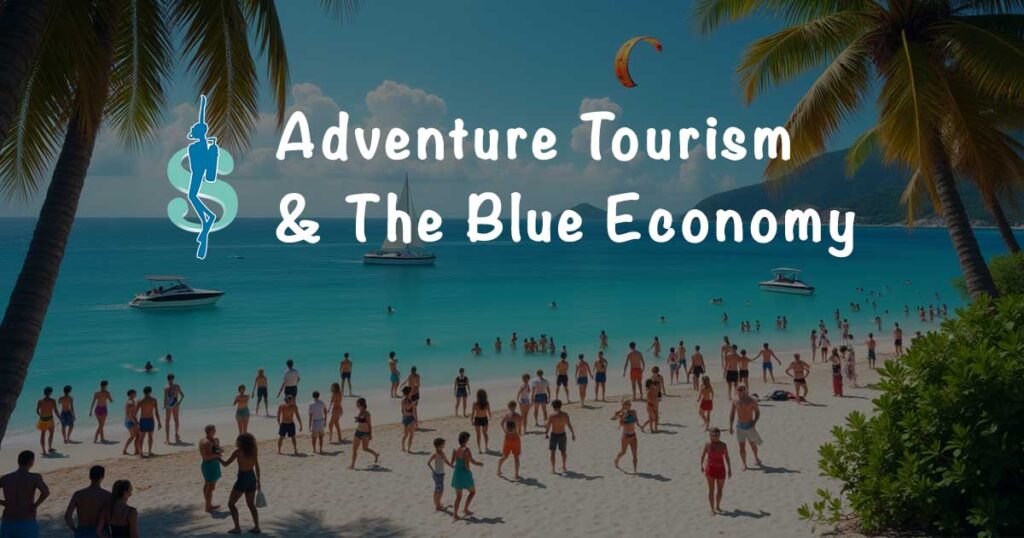Adventure Tourism & The Blue Economy
Tourism Is Often the Forgotten Stepchild of the Blue Economy
by Alex Brylske, Ph.D., President, Ocean Education International, LLC
First coined by Gunter Pauli in his 1994 book of the same name, the term “Blue Economy” describes the need for new economic initiatives that radically change society’s approach to resolving water-related issues.
The Blue Economy encompasses all sectors of the economy that utilize or in any way affect aquatic resources with the goal of encouraging sustainable use and protection of “blue resources”—all while improving both the well-being and equity of society.
The industries involved are no small matter, including renewable energy, fisheries and aquaculture, maritime transport, and waste management. However, there’s one additional blue industry I failed to mention, and it often gets short shrift—or even omitted—in the discussion. That industry in question is tourism. Perhaps the oversight is because, in comparison to the others, it may seem less important. After all, it involves leisure and not “serious work” like the other listed endeavors. But make no mistake, the role tourism plays in achieving a sustainable society is anything but trivial.
This post is part of our Blueprints 4.0 for a Healthier Dive Industry Business Model series by the Business of Diving Institute and Darcy Kieran, author of:
Contents on This Page
Tourism: The Numbers
The facts speak for themselves. According to the United Nations World Tourism Organization (WTTO), in 2012, the number of international tourist arrivals exceeded one billion for the first time ever. By 2017, it had risen to 1.3 billion, which is more than 16 percent of the entire worldwide population. And this trend is expected to continue.
International arrivals are predicted to reach 1.8 billion by 2030. Furthermore, according to the World Travel and Tourism Council (WTTC), tourism now accounts for nearly 10 percent of the global Gross Domestic Product (GDP), generating nearly one trillion dollars annually and comprising 30 percent of the world’s exports of commercial services (or six percent of total exports).
Tourism also employs over 200 million people, which is almost one in every ten jobs on earth. While these figures are astounding, what’s noteworthy from the perspective of the Blue Economy is that 80 percent of tourism occurs in coastal regions. So, to a large extent, tourism is a marine endeavor that more than justifies a co-equal position to all other Blue Economy sectors.
While big numbers are impressive, what about growth?
Again, according to the WTTC, tourism is growing annually between seven and 10 percent. However, not all tourism sectors are growing at the same rate. Many experts consider what’s referred to as “sun-sea-and-sand” travel a mature market and project only an average to flat growth rate in the coming years. But not so in the realm of “ecotourism” and other forms of nature and adventure-based tourism. In these sectors, growth is projected to be more on the order of 20 to 35 percent per year, or three times that of tourism as a whole.
Overtourism
Before you go out and invest your life savings in the travel industry, tourism is also a classic double-edged sword. Many popular travel destinations worldwide are being literally “loved to death” by the unceasing onslaught of tourists. In fact, preventing what’s now referred to as “overtourism” is perhaps the biggest challenge facing the travel industry today.
So, with the lion’s share of tourism taking place in coastal regions, it’s abundantly clear that the future of the global tourism industry is dependent upon a healthy ocean.
Social & Cultural Impact
While the environmental consequences of tourism are often obvious, other not-so-obvious results involve people.
The consequences of a rapidly expanding tourism industry have, at many destinations, been as detrimental to societies as it has to the physical environment. For instance, in many developing countries, job opportunities in tourism have encouraged the migration of people to tourism centers, often disrupting or outright destroying traditional ways of life. Already, some communities and cultures have been completely displaced or destroyed by a booming tourism trade. This social upheaval can lead to problems with crime, pollution, and a general erosion in the fabric of society.
Ironically, this can lead to a decline in the appeal of a destination because it no longer feels “authentic” to travelers, thus killing the golden egg-bearing goose.
This phenomenon is, in fact, so common and well-studied that it even has a name—the Tourism Area Life Cycle (TALC).
TALC
TALC views tourism as a dynamic process where destinations go through predictable, successive stages.
It starts when a relatively undeveloped location initially attracts a few adventurous tourists seeking pristine nature and indigenous cultures. Then, as tour operators and related businesses recognize the market potential of the location, the local tourism industry rapidly expands and develops. However, the changed nature of the now “discovered” destination causes the type of tourists initially attracted by the undeveloped nature of the location to move on to other undeveloped and pristine destinations; and the cycle is repeated.
But there’s nothing inevitable about TALC. Destinations can reverse the downward spiral by recognizing the cycle of over-tourism and unsustainable tourism practices early enough. Corrective actions can be taken, such as limiting tourist numbers, establishing marine protected areas, improving infrastructure codes, or restricting certain destructive practices.
Ideally, the entire tourism paradigm can change, but this calls for a different kind of tourism.
Call for a New Paradigm
Just as “slash-and-burn” agriculture is a recipe for disaster, so too is what some have termed slash-and-burn tourism; undiscovered destinations are not unlimited.
Tourism has become so big that we have almost run out of truly pristine travel destinations.
So, without the option of creating more places on earth, the only reasonable alternative is conducting the business of tourism in a different way, and that’s exactly what’s beginning to happen all around the world.
Tourism and tourists are changing for the better.
Adventure Tourism
Traditionally, the reason for travel has been to rest and relax—the classic “sun, sea and sand” experience. This still describes the bulk of tourists and probably always will. However, over the past few decades, there have been some significant changes.
Increasingly, tourists want more from their holiday than a suntan and souvenirs. These more intrepid travelers want a closer and more experiential encounter with the destination they visit rather than lying on the beach during the day and partying at night.
For many, the primary motivation for selecting a destination is not based on the quality of its beaches, golf courses, or nightlife but on its healthy natural environment and undisturbed culture. Or, in the words of the Adventure Travel Trade Association (ATTA), “an increasing number of travelers today want holiday experiences that are authentic, immersive, and self-directed.”
Of course, this hasn’t gone unnoticed by many within the travel industry, and this new-found recognition has led to massive changes in travel products and how they’re marketed.
The evolution of adventure travel can be traced to early attempts to meet the demand of changing attitudes toward tourism, which led to the development of the ecotourism industry. From this evolved the idea that travel should serve not only the tourist but also the destination and its inhabitants (more about this in Tourism 4.0).
As ecotourism became more mainstream, newer and more authentic directions were explored, and the market was segmented into many more specialized sectors and activities. Then, with the growing recognition of the declining state of the environment, many in tourism began to realize that making tourism more accountable to both the local environment and residents could no longer be just a specialized endeavor targeted to “tree-huggers.”
All forms of tourism must become part of the solution and not part of the problem.
From this movement was born the idea of “responsible tourism,” or what’s become better known as “sustainable tourism”—an off-shoot of the growing concern for sustainable development.
Sustainable Tourism
But what exactly does sustainable tourism really mean?
While arguments rage among the experts in the field, one of the best functional definitions has been offered by those who have been involved in international tourism since its inception, Caribbean islanders.
According to the Organization of Eastern Caribbean States, sustainable tourism is defined as “the optimal use of natural and cultural resources for national development on an equitable and self-sustaining basis to provide a unique visitor experience and an improved quality of life through partnership among government, the private sector and communities.”
Importantly, this definition recognizes that tourism isn’t just an economic activity. As it has both environmental and cultural consequences, so too must it take into account, and be responsible for, its effects. This ethos is exemplified in the commonly used sustainable tourism mantra “people, planet, profit” or what some have termed the “triple bottom line.”
In general, sustainable tourism has six underlying goals. These include:
- minimizing environmental impacts;
- improving local contribution to sustainable development;
- protecting the quality of the environment by maintaining biological diversity and ecosystem function;
- minimizing the use of non-renewable resources;
- ensuring cultural integrity, local ownership, and social cohesion of the community; and last, but certainly not least,
- providing a high-quality experience for tourists.
The Future of Tourism
Today, savvy tourism operators trying to cater to the new, more environmentally and socially-conscious traveler have a daunting task.
No longer can they be satisfied by having the nicest hotel and restaurant, the best beach, or even the most exciting tours. Study after study has shown that many travelers today are just as or more concerned with their travel provider’s environmental and social footprint as they are with the actual product.
So, travel providers and destinations today aren’t turning to sustainability because it’s a nice thing to do for the earth or future generations. They’re doing so because it makes business sense and realize that not doing so will, at some point, mean they’ll no longer be in business.
As a popular protest slogan tells us, “There is No Planet B.”
You may also be interested in Brown, Sustainable or Regenerative Blue Economy vs. Tourism & Scuba Diving.
If you found the information on this page valuable, would you consider buying me a coffee?
Either way, let’s work together on “raising the bar” in the dive industry to satisfy today’s consumers!
Your Dive Industry Compass
Scuba Diving Market Research, Surveys, Reports & Statistics
Blueprints 4.0: A Healthier Business Model
Scuba Diving Industry Structure, Competitive Analysis, Business Models & Strategies for Growth With The New Scuba Diver
Living The Scuba Dream
Plan Your Scuba Instructor Career & Deep Dive the Plan
You may also be interested in The Immersion Zone (our podcast), Scubanomics (our newsletter for dive professionals), and our published books & reference guides.





